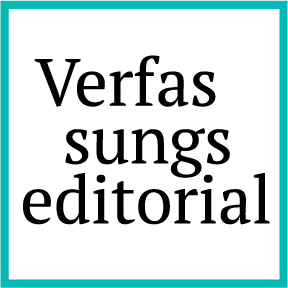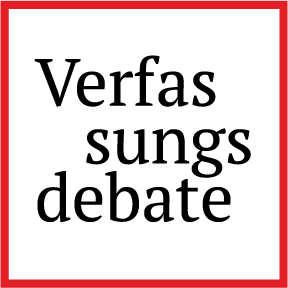Glancing Beyond Europe
On 9 May 1831, a young French aristocrat trained as lawyer arrived in Rhode Island for a nine-months visit to the United States. Officially tasked by the French government with studying the American prison system, his ambition and desire for political and literary fame propelled him to conduct a much broader study of the character of the American Republic. Based on his observations, the young lawyer wrote a book that remains a seminal work in constitutional and democratic theory to this day: Democracy in America.
Alexis de Tocqueville has a towering influence on American political discourse, and he is frequently cited by Republicans and Democrats alike. His work is of interest to any constitutional scholar, political theorist, political sociologist, historian of the Early American Republic, or scholar of federalism. But Democracy in America also holds important insigths for the study of the European Union.
Constitutional resemblance
There is a striking resemblance between Tocqueville’s description of the constitutional realities of the Early American Republic and those of the present-day European Union. In Tocqueville’s account of the Early American Republic, real political life was anchored not in the Union, but in the states. In terms of their political sentiment, Americans first and foremost identified with their state and thought of themselves as New Yorkers, Massachusettsans, Virginians, and so forth:
“The Union is a vast body which presents only a dimly perceived image to inspire patriotic feelings. The state has a distinct shape and clearly drawn boundaries; it represents a certain number of familiar things cherished by its inhabitants. It is identified with the very soil itself, with property, family, past memories, present activities, future dreams. Patriotism, frequently only the extension of private egoism, has, therefore, remained attached to the state and has not yet, so to speak, passed on to the Union.” (Democracy in America p. 431)
In the 1830s, when Tocqueville travelled around the United States, state constitutions as well as the political life of the states played the dominant role in the American Republic. The “state governments remained the general rule and the federal government the exception”, Tocqueville wrote (Democracy in America p. 134). When Tocqueville discussed the dangerous potential of popular democracy, the “tyranny of the majority”, he was more concerned with state legislatures than with the federal government. The federal government, Tocqueville wrote, was a “weak government” whose survival depended entirely on the free support of its citizens (Democracy in America p. 431). In terms of their actual strength, it was the states, not the Union, that came out on top, and there was no doubt that they deprived the Union of its unconditional supremacy:
“If the sovereignty of the Union were to come into conflict with that of the states, one can readily foresee that it would be defeated; I doubt whether the fight would ever be undertaken in any serious fashion. Whenever determined resistance is offered to the federal government, it will be found to yield. Experience has shown so far that whenever a state has been stubbornly determined on anything and was resolute in its demands, it never failed to obtain it and when it has flatly refused to act it was left to do what it wanted.” (Democracy in America p. 432)
The constitutional reality of the Early American Republic, as explained by Tocqueville, is far removed from the contemporary United States, where the federal government unquestionably is the dominant seat of power, authority, and identity. The past is a foreign country, as historians put it. For EU constitutional scholars, on the other hand, Tocqueville’s account of the constitutional reality of the Early American Republic is strangely familiar.
Abandoning the familiar dichotomy
Today, constitutional scholars find it difficult to conceptualize such a reality. They have therefore come up with a plethora of new constitutional theories to account for the European Union’s allegedly “sui generis” nature. Notwithstanding the fact that many of these theories are interesting, perhaps we are better served by recovering an old idea rather than turning to new ones if we are to understand the nature of the beast. In Tocqueville’s time, the American Republic was referred to as a federal union or a federal republic – an idea that can readily account for the constitutional nature of the European Union.
The idea of a federal union or a federal republic is no longer well-understood. Today, “federal” generally carries the opposite meaning of what it did for most of the history of political thought. In most contemporary scholarship, as well as broader political debates, the federal idea is associated with a strong, centralised government that wields extensive powers over clearly subordinate units, such as states, cantons, and provinces. This idea is contrasted with what is usually referred to as a confederation of fully sovereign states.
The literature thus draws a familiar distinction: the federal state is constituted by public law, whereas the confederation is created by international law; the federal state is founded on a constitution, whereas the confederation is founded on a treaty; the federal state is an expression of constitutionalism, whereas the confederation is an expression of diplomacy. This distinction is attractive to constitutional scholars because it is simple, conceptually clear, and – most importantly – protects the integrity of the theory of the state by conceptualizing the federation as either a single sovereign state, albeit decentralized, or as multiple sovereign states, albeit held together by a complex system of international law. Conveniently, either the Union or its composite units are declared sovereign and hence wield ultimate authority. In this way, the difficult and uncomfortable constitutional questions regarding autonomy and authority are dissolved. Unfortunately, the cost of this solution is that reality is often ignored. In order to make the nature of federal public law fit the mould of the theory of the state, it is necessary to overemphasize the significance of either the Union or its composite entities, the Member States.
The argument for the EU’s “sui generis” nature relies on this familiar distinction: the Union is somehow more than a confederation yet less than a federal state. It blurs the line between public law and international law; between constitution and treaty; between constitutionalism and diplomacy. But the EU is not the only union that cannot be fully understood through the traditional dichotomy of confederation and federal state. The absurdity of applying the theory of the state, and the concepts derived from it, to the ante-bellum United States is showcased by Daniel Deudney:
“While the Philadelphian system certainly was federal, it was as much an antistate as a state. It had a government but was not a state. (…) the Philadelphian system had significant resemblance to both a confederation and a federation but differed from them in that its union was organized. The union government decisively penetrated into the states, leaving the units, the union organs, and the people coordinated and mutually constrained (…) More than a confederation of states in anarchy, and less than a state with extensive devolution, the complex structure of the Philadelphian system seems to defy simple classification.”
This description will be more than a little familiar to EU scholars.
Today, the distinction between a sovereign federal state and a confederation of sovereign states is largely taken for granted across law and political science. So much so, that many scholars presume this framework has always been the sole method for conceptualizing federations. However, this distinction is a relatively recent invention when considering the long history of federal political thought, which is as old as the theory of the state itself. The dichotomy between a sovereign federal state and a confederation of sovereign states was most likely imported into English towards the end of the nineteenth century as a translation of the dichotomy between Staatenbund and Bundesstaat. In German scholarship, the concept of the “federal state” had been introduced into the academic debate by Georg Waitz in his 1853 publication The Nature of the Federal State (Das Wesen des Bundesstaates). Nevertheless, it was only after the release of Max von Seydel’s The Concept of the Federal State (Der Bundesstaatbegriff) in 1872 that the term began to reflect the meaning it holds today (see Rupert Emerson’s State and Sovereignty in Modern Germany). One of the first books I have been able to find in Anglo-American academia, which discusses the dichotomy between confederation and federal state is Woodrow Wilson’s The State: Elements of Historical and Practical Politics. A Sketch of Institutional History and Administration published in 1889.
Until the middle of the nineteenth century, the concept of a “federal state”, to the extent it was used at all, typically referred to the composite parts of a federal union (that is, a “Member State” in the language of EU law).
Reconnecting with forgotten federal traditions
Before the theory of the federation was co-opted by the theory of the state, federal theory was concerned with understanding the nature and dynamics of federal unions or federal republics. Within this tradition, it was generally understood that federations could not be explained based on the theory of the state or the concept of indivisible and ultimate sovereignty. This older tradition of federal theory influenced Americans of the founding generation during the drafting of both the 1777 Articles of Confederation and Perpetual Union and the 1787 Constitution of the United States of America.
The federal idea Americans of the founding generation relied on dates back to the early modern period, where it arose as a rival theory of political associations to the emerging theory of the state. It was used to account for political unions like the United Provinces of the Netherlands (Republiek der Zeven Verenigde Nederlanden) and the Swiss Confederation (Corpus Helveticum). These federal unions were in some cases referred to as “confederations”. However, it is important to stress that this concept had a broader meaning than it does today since it encompassed both constitutionalism and diplomacy. Tocqueville therefore referred to the United States – in the plural! – as both a “republic” and a “confederation”: “Not only do [sic] the United States form a republic but also a confederation” (Democracy in America p. 136). A federal union or a federal republic is a polity composed of other polities. In The Spirit of the Laws, Montesquieu defined a federal republic as a “society of societies”. Although without reference to federal constitutional theory, this is precisely the definition now being used by scholars such as Armin von Bogdandy to describe the European Union.
Within constitutional scholarship, the “old” tradition of federal political thought is unfortunately widely forgotten. In The Constitutional Theory of the Federation and the European Union, I recover this tradition by setting out a coherent constitutional theory of the federation and I demonstrate that it can account for the constitutional nature of the EU. I argue that the pervasive argument that the EU is not a “real” federation because it is not a state is misguided. The federation should be considered a form of political association on a par with yet distinct from the state and worthy of its own constitutional theory. The argument that the EU is not a “real” federation because it is not a state would have puzzled Tocqueville, together with other Europeans such as Georg Wilhelm Friedrich Hegel (who passed away the year Tocqueville embarked on his voyage to America). They did not consider a federal republic like the United States to be a “state” either. (For a discussion of Hegel’s views, see GA Kelly, Hegel’s America (1972) 2 Philosophy & Public Affairs 3.)
Comparative federalism and the EU
Conceptualising the EU as a federation allows us to escape the methodological solipsism of EU studies and engage in comparative federalism. Democracy in America remains one of the founding texts showcasing the strength of the comparative method. Throughout the book, Tocqueville compares and contrasts what he observes in America with political affairs not merely in France but also in Britain, Canada and Mexico, as well as with his historical knowledge of empires and republics of the past. It was this comparative and historical method that allowed Tocqueville – a French, catholic, aristocrat – to write the most penetrating account of American democracy and rise to become one of America’s most influential public philosophers.
Paraphrasing Tocqueville, we might conclude, that for any study of the European Union, it is necessary to glance beyond Europe; for whoever has studied and seen only Europe, will never understand anything about the European Union.



